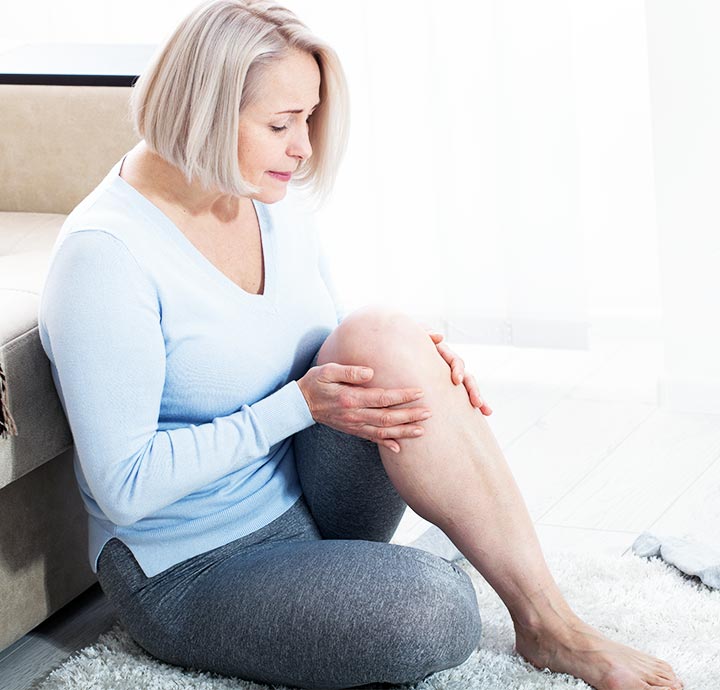
Osteoarthritis pain is pain that’s associated with a degenerative disease affecting the joints called osteoarthritis (OA). Pain is one of the most prevalent symptoms of this disease. Osteoarthritis is the most common of the many different types of arthritis. The condition can affect any joint in the body although it most commonly involves the knees, lower back, hips, hands and neck.
Pain from osteoarthritis typically develops gradually, progressively worsening over time. In some cases, however, osteoarthritis can advance more rapidly, especially in a joint that was previously injured.
People typically experience pain from osteoarthritis during physical activity or after a long, active day. The pain often improves with rest but pain and stiffness can also occur following long periods of inactivity. Moving the affected joint will generally trigger osteoarthritis pain. The area may also feel tender to the touch.
Osteoarthritis pain is often accompanied by other osteoarthritis symptoms such as stiffness, joint instability, loss of range of motion and swelling. Osteoarthritis pain can make it difficult to enjoy daily activities, negatively impacting quality of life.
With osteoarthritis, pain occurs when there’s damage to the cartilage and other soft tissues of the joint, including tendons and ligaments. Osteoarthritis also causes structural changes to the surrounding bone.
When cartilage wears away, joints become less effective at absorbing shock and reducing friction. Osteoarthritis also causes increased stretching of ligaments and tendons, further contributing to discomfort. With advanced cases of osteoarthritis, bones may rub directly against each other and bone spurs can develop.
Osteoarthritis is more common in people over 50 due to structural changes in the body that occur over time. However, other factors can contribute to the development of OA, including:
Gender — Women are more likely than men to develop osteoarthritis.
Heredity — Osteoarthritis is more prevalent in those who have a family member with the condition. Defective cartilage and genetic abnormalities affecting joint structure play a role in OA.
Weight — People who are overweight have an increased risk of osteoarthritis since extra weight puts pressure on the joints.
Joint injuries — Osteoarthritis is more common among people with past joint injuries from sports or an accident. Overuse of a particular joint due to athletic training or work requirements can also increase the risk of osteoarthritis.
Several at-home and over-the-counter remedies are available to address mild to moderate osteoarthritis pain, including:
• OTC NSAIDs— Oral over-the-counter non-steroidal anti-inflammatory drugs like naproxen and ibuprofen can reduce pain and inflammation associated with osteoarthritis.
• Topical pain relievers— Topical anesthetics and other types of topical pain relievers can help minimize osteoarthritis pain. These types of pain relievers typically come in the form of a gel, ointment or cream, and they may contain menthol, salicylates, lidocaine, capsaicin or diclofenac sodium.
• Hot and cold therapy— Alternating ice packs with a heating pad may help alleviate osteoarthritis pain. Ice can help reduce inflammation while heat can help improve circulation and promote muscle relaxation.
• Orthotics— It can be beneficial to wear orthotics inside of your shoes in order to protect joints against stress and shock. Scholl’s®Knee Pain Relief Orthotics are designed specifically for people who suffer from knee pain, includingosteoarthritis knee pain. The orthotics promote even weight distribution while reducing shock to painful knees.
For more severe pain that doesn’t improve with over-the-counter treatments and home remedies, see your doctor. You may require stronger treatment such as:
• Corticosteroids— Your doctor may recommend corticosteroid injections which can be administered directly into the affected joint to reduce pain and inflammation. Oral steroid medications are also available by prescription.
• Prescription anti-inflammatories and pain relievers— If over-the-counter NSAIDs don’t provide relief for osteoarthritis pain, your doctor may prescribe stronger NSAIDs and pain medications.
• Surgery— Advanced cases of osteoarthritis may require surgery to reduce pain and improve quality of life. Surgical options include joint replacement, arthroscopy, osteotomy and joint fusion.

There are a number of ways to manage osteoarthritis pain and improve mobility and quality of life.
- Exercise — While it can be painful to move joints afflicted with osteoarthritis, exercise is important for strengthening the muscles that support joints. Exercise can also improve flexibility and range of motion. Check with your doctor before starting an exercise routine.
- Physical therapy — Like exercise, physical therapy can help improve muscle strength and flexibility. A physical therapist can devise a program tailored to your needs.
- Weight maintenance — Since excess weight can put pressure on painful joints and contribute to the progression of osteoarthritis, it’s important to achieve and maintain a healthy weight.
SOURCES
https://www.arthritis.org/diseases/osteoarthritis
https://www.cdc.gov/arthritis/basics/osteoarthritis.htm
https://www.mayoclinic.org/diseases-conditions/osteoarthritis/symptoms-causes/syc-20351925
https://www.hopkinsmedicine.org/health/conditions-and-diseases/arthritis/osteoarthritis
https://www.arthritis.org/diseases/osteoarthritis
https://www.healthline.com/health/osteoarthritis-stages-of-oa-of-the-knee
https://www.webmd.com/osteoarthritis/stages-knee-osteoarthritis
https://my.clevelandclinic.org/health/diseases/5599-osteoarthritis
https://www.webmd.com/osteoarthritis/hyaluronic-acid-injections-for-osteoarthritis
https://www.webmd.com/osteoarthritis/medicines-treat-oa
https://www.disabilitybenefitscenter.org/disability-work/osteoarthritis
https://www.webmd.com/arthritis/understanding-arthritis-basics
https://www.urmc.rochester.edu/encyclopedia/content.aspx?contenttypeid=1&contentid=1411
https://www.webmd.com/arthritis/heat-and-cold-therapy-for-arthritis-pain
https://www.webmd.com/pain-management/pain-management-osteoarthritis
https://www.webmd.com/osteoarthritis/guide/osteoart
hritis-basics
https://www.ncbi.nlm.nih.gov/pmc/articles/PMC2818253/
https://www.ncbi.nlm.nih.gov/pmc/articles/PMC6669258
https://www.webmd.com/osteoarthritis/osteoarthritis-surgery-for-joint-pain-relief
https://www.arthritis.org/health-wellness/healthy-living/physical-activity/getting-started/benefits-of-exercise-for-osteoarthritis


